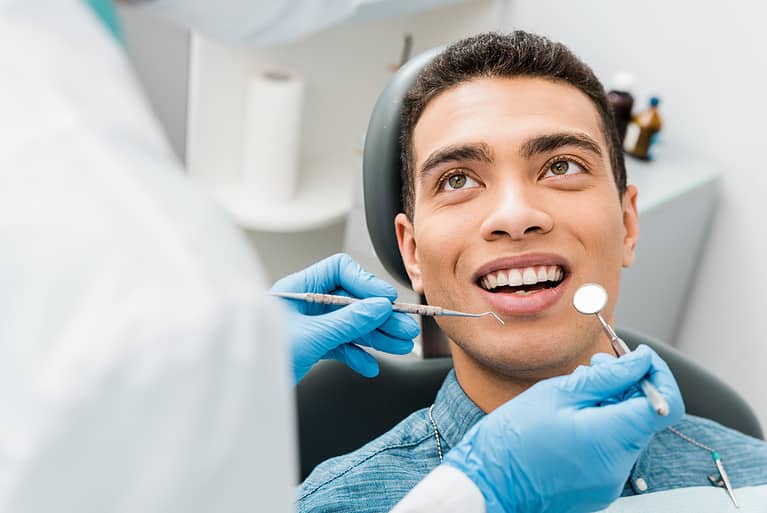Invisalign is a type of orthodontic treatment that uses clear, removable aligners to straighten teeth gradually. It is an increasingly popular option for those who wish to improve the appearance of their smile without the need for traditional metal braces.
This article will examine how long Invisalign typically takes to achieve desired results and the factors which can affect treatment duration. Additionally, this article will explore the benefits of Invisalign and the alternatives available if Invisalign is not suitable. The information presented here should help patients make an informed decision when considering orthodontic treatments.
Learning About Invisalign
Invisalign has become a popular choice among adults and teens alike due to its discreet appearance and convenience, as it does not require regular visits to the dentist or orthodontist during treatment. As with any medical procedure, however, it is important to understand how long Invisalign will take before deciding whether or not it is right for you.
The average length of time for a full course of Invisalign treatment varies from person to person depending on several factors, such as the complexity of the case, compliance with wearing aligners, and other individual considerations.
Overview of Invisalign Treatment
Invisalign is an orthodontic treatment option that offers a discreet and comfortable way to achieve desired results. This invisible treatment uses aligner trays, custom-made from 3D computer imaging technology, to gradually move the teeth into the desired position.
The process begins with a digital treatment plan that includes images of straightened teeth and a timeline for achieving this result. The cost of Invisalign treatment is determined by the complexity of the patient’s misaligned teeth and how long it will take to correct them.
The duration of Invisalign treatment varies depending on the individual’s needs but typically takes between 9 and 15 months. During this time period, patients must wear their aligners for 20-22 hours per day in order to gain maximum benefit from their treatment.
Each set of aligners should be worn for two weeks before switching to the next set in line with the prescribed digital treatment plan; throughout this process, patients may need periodic visits with their orthodontist or dentist for adjustments or checkups.
The primary benefit of Invisalign over traditional braces is its convenience and discretion; however, it may not be suitable for all types of misaligned teeth cases, and some people still opt for metal braces instead.
Regardless of which type of orthodontic device is chosen, proper maintenance both during and after a patient’s course of treatment is essential in order to maintain straight teeth once they have been achieved.
Regular brushing and flossing are important habits that should be developed early on in life; when combined with regular visits to a dental professional every six months, these practices can help ensure healthy smiles remain beautiful year after year, even after completion of an orthodontic alignment program such as Invisalign – ensuring everyone can show off their own confident smile! Moving forward, we’ll take a look at how long one can expect Invisalign treatments to last on average.
Duration of Treatment
Treatment with Invisalign typically requires a period of several months for completion. The duration of treatment can vary greatly depending on the severity and complexity of the malocclusion and the patient’s compliance with wearing their aligners. Generally, orthodontic treatments take approximately one to two years to complete; some patients may complete treatment in as little as three to six months, while others may require up to eighteen months or more.
The average treatment time for Invisalign is usually between nine and fifteen months, but this could be shorter or longer depending on individual circumstances. Factors such as the alignment of your teeth at the beginning of treatment, how quickly you change out your aligners every two weeks, and any necessary mid-treatment adjustments can all affect differences in treatment duration. Therefore it is important that you adhere exactly to your orthodontist’s instructions in order to ensure successful results within an appropriate timeframe.
When considering orthodontic treatments such as Invisalign, it is important to understand that each case is unique and will require a different amount of time for successful completion. Patients should discuss their expectations with their orthodontist before committing to any type of treatment plan so they can have realistic expectations about the potential duration of their specific case.
For best results with Invisalign, close monitoring by an experienced orthodontist throughout the course of treatment is recommended; this will help ensure that almost any type of malocclusion can be successfully corrected within a reasonable timeframe without compromising quality results or safety.
Moving forward into the next section about factors affecting treatment time, it’s important to keep these considerations in mind when determining how long Invisalign could take for you specifically.
Factors Affecting Treatment Time
Recent studies suggest that the duration of orthodontic treatments, such as Invisalign, is impacted by a variety of factors depending on the individual case.
As many people know, this type of treatment is based on using aligner trays made from plastic which patients wear for around 20-22 hours per day.
The length of time to complete a successful Invisalign treatment will depend upon several different components, such as how frequently the aligners are worn, how well they fit and if any foods were eaten during treatment that can affect the fit.
The professional opinion of an orthodontist will also be key in determining how long it may take for an individual’s teeth to move into alignment with their desired goal.
This process can take anywhere from 6-18 months, with some cases taking even longer depending on the severity of the patient’s misaligned teeth or gaps between them.
Once an orthodontist has created a personalised treatment plan, it should provide an estimated timeframe for which upper teeth and lower teeth will shift into place accordingly.
To ensure optimal results when wearing aligner trays, individuals must follow instructions given by their doctors carefully and adhere to all guidelines while wearing them throughout their course of treatment.
Eating certain sticky or hard foods while wearing them could potentially cause damage or result in lengthening their overall aligner treatment time due to needing more sets to get back on track with realigning teeth correctly.
The amount of time needed for completing Invisalign treatment varies greatly amongst different cases; however, there are still a few constants that must be consistently adhered to in order for successful outcomes, these being regular visits to your orthodontist and always following their guidance regarding proper care and usage of aligner trays over the duration of your personalised treatment plan.
Benefits of Invisalign
Through its discreet and comfortable approach, Invisalign can offer individuals the opportunity to realign their teeth with minimal disruption to their daily lives. This system of invisible aligners is a revolutionary orthodontic treatment that offers numerous benefits:
- Removable Aligner: The clear plastic aligners are designed to fit snugly over your teeth and can be removed at any time for eating, brushing flossing or special occasions.
- Custom-developed Clear Aligner Trays: With this treatment, each patient receives custom-developed clear aligner trays that are worn for two weeks before being replaced by the next set in the series.
- Straight Smile: Thanks to Invisalign’s gradual realignment process, you can achieve an attractive straight smile without metal brackets and wires.
- Comprehensive Smile Evaluations: Prior to beginning treatment with Invisalign, patients receive comprehensive smile evaluations from a professional consultation. During this time the orthodontist will determine if Invisalign is the right solution for correcting crooked smiles and misaligned bites.
In addition to offering a convenient and discreet way of improving one’s appearance through realigning teeth, Invisalign also provides patients with peace of mind knowing they are receiving quality care from a trained professional.
With its many benefits, it’s no wonder why so many people choose Invisalign as an alternative for attaining an aligned smile. Moving forward into exploring alternatives to Invisalign might help one decide on which option would best suit them in achieving their desired look and lifestyle goals.
Alternatives to Invisalign
Recently, a variety of orthodontic treatments have emerged as viable alternatives to Invisalign, offering patients a range of options to suit their individual needs and preferences, like the changing pages in a book.
Invisible people who want discreet braces no longer need to rely on cumbersome metal braces as an overbite correction treatment. Instead, alternative options such as ceramic braces or a combination of braces are now available for those seeking better alignment without the idea of metal wires and brackets.
The advantages offered by these alternative treatments can be significant. Unlike traditional metal braces requiring frequent visits to an orthodontist for adjustments, invisible aligners can be adjusted at home with minimal hassle. This means that the entire process is much more convenient and personalized than before.
Additionally, many invisible aligners come with features such as clear retainers that allow you to eat and drink while wearing them—something that cannot be done with traditional braces.
In some cases, it may even be possible to combine different types of treatments in order to achieve optimal results. For instance, one could opt for both invisible aligners and ceramic braces in order to get the best possible outcome from their treatment plan. This type of personalization allows patients to tailor-make their own plans based on their unique needs and preferences without compromising on quality or efficacy.
Combining various forms of orthodontic treatments has become increasingly popular due its ability to provide quicker results than either option alone would have achieved previously; this is what makes combination therapies so attractive for those looking for an effective solution without having to wait too long for visible changes in their smile’s appearance.
Key Takeaways
Invisalign is an innovative orthodontic treatment that offers a discreet and comfortable way to align teeth. Treatment duration varies depending on the severity of misalignment but typically lasts around 12-18 months.
During this journey, patients can expect gradual improvement in their smiles as they progress through each set of clear aligners. By the end of treatment, patients will be rewarded with a beautiful, straightened smile like a pearl in its oyster shell – one that will last for many years to come.
Invisalign is an incredibly effective and efficient method of achieving desired results. However, there are alternatives available if it doesn’t fit everyone’s needs. Ultimately, there’s no one-size-fits-all solution when it comes to orthodontic treatments; rather, it’s important to find the right option for you and your lifestyle. Keeping Invisalign properly clean extends the invisalign’s life.
Welcome to Ashfield Family Dental, where we provide Invisalign and other orthodontic treatments to help you achieve the perfect smile. Our experienced team is committed to helping you reach your desired results in the most comfortable and effective manner. We invite you to book an appointment to speak to one of our friendly staff about your orthodontic needs today!




